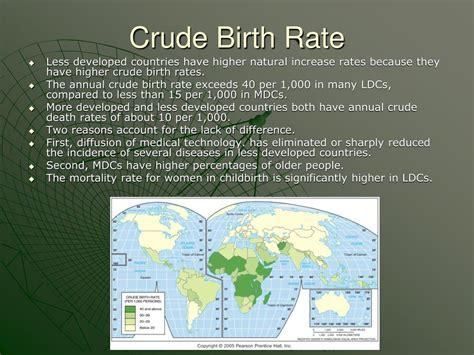Understanding the Concept
The crude birth rate (CBR) is a fundamental demographic indicator used to measure the fertility of a population. It represents the number of live births in a given year per 1,000 people in the mid-year population. This rate provides insights into the overall population growth, reproductive patterns, and the health and well-being of a society.

Calculation and Interpretation
The CBR is calculated using the following formula:
CBR = (Number of live births in a year / Mid-year population) x 1,000
A higher CBR indicates a more rapidly growing population, while a lower CBR reflects a slower or even declining population growth rate. The World Bank categorizes countries into three fertility levels based on their CBR:
- High fertility: CBR of 20 or more per 1,000 people
- Medium fertility: CBR between 15 and 19.9 per 1,000 people
- Low fertility: CBR below 15 per 1,000 people
Global Trends
Globally, the CBR has been declining in recent decades. In 1950, the estimated global CBR was 37.2 per 1,000 people. By 2020, it had fallen to an estimated 18.0 per 1,000 people. This decline is attributed to factors such as increasing education, urbanization, and access to contraception.
Factors Influencing CBR
Numerous factors can influence the CBR of a population, including:
- Socioeconomic factors: Education, income, and access to healthcare
- Cultural factors: Religious practices, marriage patterns, and family values
- Political factors: Government policies on family planning and reproductive health
- Environmental factors: Climate, availability of food, and natural disasters
Significance and Applications
The CBR has significant implications for various aspects of society and policy-making:
- Population planning: Estimation of future population size and growth rates
- Resource allocation: Planning for infrastructure, healthcare, and education needs
- Forecasting labor force: Assessing the availability of skilled workers and economic growth potential
- Social welfare: Addressing issues of poverty, unemployment, and housing shortages
Challenges in Calculating CBR
- Data availability: Accurate data on births and population size is crucial for reliable CBR estimates. However, data collection can be challenging in less developed countries.
- Demographic dynamics: Fluctuations in fertility rates due to factors such as war, migration, or natural disasters can make it difficult to establish a stable trend.
- Cultural biases: Cultural norms and taboos can affect the reporting of birth data, leading to potential undercounting or overcounting.
Conclusion
The crude birth rate is a vital indicator of a population’s reproductive health and growth patterns. It provides valuable insights for policymakers, researchers, and anyone interested in understanding demographic trends and their implications for society. By comprehending the factors that influence the CBR and addressing associated challenges, we can contribute to a more sustainable and prosperous future for all.
Further Exploration
- World Bank Data: Crude Birth Rates
- UN Population Fund: Birth Rates
- CIA World Factbook: Crude Birth Rate
Tables
| Region | Crude Birth Rate (2020) | Fertility Level |
|---|---|---|
| Africa | 24.4 | High |
| Asia | 17.0 | Medium |
| Europe | 9.9 | Low |
| North America | 12.3 | Medium |
| South America | 17.3 | Medium |
| Country | Crude Birth Rate (2020) | |
|---|---|---|
| India | 16.4 | |
| China | 10.48 | |
| United States | 12.3 | |
| Nigeria | 34.7 | |
| Japan | 7.5 |
| Factor | Effect on CBR |
|---|---|
| Education | Negative |
| Income | Negative |
| Access to healthcare | Negative |
| Religious practices | Variable |
| Marriage patterns | Variable |
| Family values | Variable |
| Application | Importance |
|---|---|
| Population planning | Estimations of future population size and growth rates |
| Resource allocation | Planning for infrastructure, healthcare, and education needs |
| Forecasting labor force | Assessing the availability of skilled workers and economic growth potential |
| Social welfare | Addressing issues of poverty, unemployment, and housing shortages |
